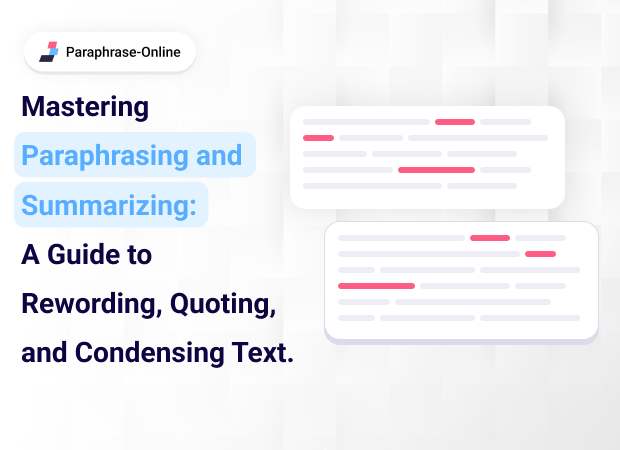Are you a student or a professional content creator? If so, you may need to paraphrase or summarize content quite often. In many cases, writing research-based assignments and articles isn’t possible without these two things. Therefore, people must learn to effectively paraphrase and summarize content.
Unfortunately, many struggle with both of these things. As a result, they make their content less engaging and valuable. Do you want to learn the art of paraphrasing? Don't fret. Mastering these skills isn't challenging at all.
By using some simple techniques, you can perfectly paraphrase or summarize anything. And here, we will acquaint you with those.
Let's first understand what they are!
What is Paraphrasing?
Paraphrasing is rewording any text or spoken words while maintaining the essence of the content. The primary purpose of paraphrasing is to enhance the clarity of the content and make it more understandable for a specific audience. Students and content creators are also using this technique to remove plagiarism from their content and make it look original.
As you cannot always copy others' work or add direct quotes everywhere, you need this particular skill to convey the same information using different words. Paraphrasing requires a strong grip on the language. Without it, you may fail to effectively paraphrase even a single sentence. The command of the language allows people to find better words to convey the same message and restructure sentences to prevent plagiarism.
What is Summarizing?
On the other hand, summarizing is the process of condensing larger texts and making them shorter and more straightforward. In summarizing, people need to focus on the text's key points and remove all the unnecessary details that provide no value but enhance the length of the content. Summarizing is helpful when you want to give an overview of books, movies, or other types of content in the fewest words possible to help readers grasp the main idea without going through all the details.
Summarization is used in multiple domains, including academia, journalism, and digital marketing. Generally, students, journalists, and copywriters need to convey maximum information in limited words. So, they condense the text and only provide relevant and helpful information.
Summarizing vs. Paraphrasing
Although both these things have a few things in common, they are entirely two different things. Let's learn about the key differences between summarizing and paraphrasing.
- Writers have to condense the original text when summarizing, and when paraphrasing, they have to rewrite the text without condensing much information.
- Summarized content only contains the main idea. In contrast, paraphrased content includes all the information.
- Writers must shorten the content when summarizing. On the other hand, they must not change the content length when paraphrasing.
- Writers don't need to keep the original structure in paraphrasing. However, in paraphrasing, they should stick to the original structure.
- Summarizing requires simplifying the content. Whereas paraphrasing doesn't need oversimplifying.
Tips to Effectively Paraphrase an Article
Paraphrasing isn't that difficult at all. Even if you don't know much about it, you can still do it with maximum precision. Want to learn about tips and steps for paraphrasing an article? Here they are!
Understand the Content
Before you start the paraphrasing process, understand the entire content. To do so, read the entire content carefully. It will help you grasp the message and understand what changes you must make to maintain the context and perfectly communicate the message.
Use Your Own Words
Whenever you want to paraphrase a piece of content, use your own words. Never use the exact words the original author has used. It will help you ensure originality and reflect your voice and tone. However, if you don't know other words to discuss a phenomenon, you can get help from Google and thesaurus platforms. They will help you find the right words to describe something.
Change Sentence Structure
Generally, people think that changing words is enough for paraphrasing. However, they aren't. To avoid plagiarism, you also need to change the sentence structures. It can help if you modify the overall sentences and bless them with a unique look.
Retain Original Meaning
In paraphrasing, you can change the sentence structure and words, not the original context. Therefore, you must not make any changes to it. Therefore, you should stick to the original idea and explain it in your own words.
Leverage Online Paraphrasing Tools
Don't know how to paraphrase? Then, still, there is no need to worry about it. If you are struggling to paraphrase something, you can leverage an online paraphrasing tool. A modern paraphrasing tool that uses AI technology can help you quickly and precisely paraphrase any type of content. Also, it will polish the language and make content more understandable for everyone.
Tips to Effectively Summarize an Article
Want to learn how to summarize an article? It's also very easy. Like paraphrasing, a few simple strategies can help you summarize any type of content perfectly. Let's get ourselves acquainted with them as well!
Read the Content Thoroughly
Like paraphrasing, when you want to summarize something, the first thing you should do is to read the entire content thoroughly. You must wait to start the summarizing process. First, read the text multiple times to understand everything perfectly. Once you know it, the following process will become much easier.
Identify Key Points
While reading the content, you should identify all the key points and note them down. This practice will help you learn which things to mention in the content and which to avoid. However, make sure to include the thesis statement and key arguments while identifying the key points. It will help you perfectly convey the author's message.
Don't Mention Unnecessary Details
When it comes to summarizing, only mention necessary details. Generally, content creators write many things just to set the background and provide additional information to content consumers. You must miss all those things and not mention them at all.
Organize Information Logically
In summarizing, you must organize all the information logically. Present the key points in the original order. Never randomly mention different sections. If you do so, you may ruin the content and its essence. Also, organizing things logically will help you maintain the flow.
Utilize Modern Summarizing Tools
Thankfully, various summarizing tools are available online. If you want to effectively summarize something without ruining its message, you can use a sophisticated summarizing tool for that. An advanced summarizer will help you quickly summarize the text according to your requirements.
Conclusion
Paraphrasing and summarizing can help you in many ways. Therefore, you must master the art of paraphrasing and summarizing. Implement the simple strategies mentioned in this article. You will surely be able to paraphrase or summarize any type of text with ease.



 Worst
Worst Bad
Bad Good
Good Nice
Nice Amazing
Amazing









 Pricing
Pricing






